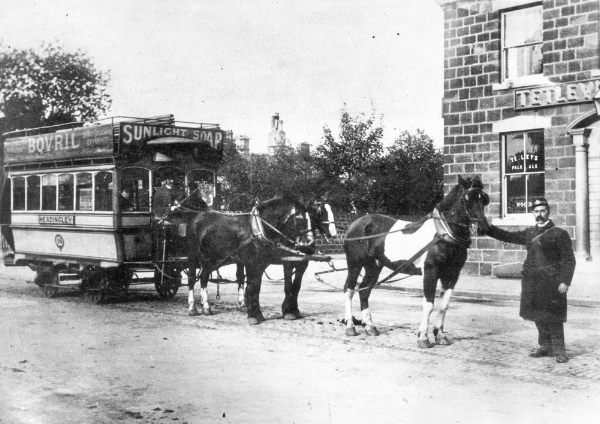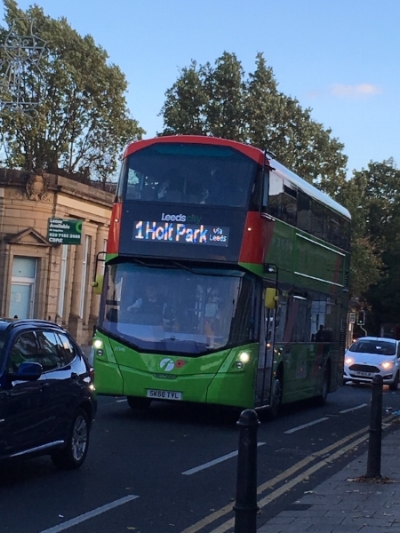A suburb is a place outside a town, but connected to it. For over a thousand years, Headingley village lay outside Leeds, but barely connected – the road which led from Leeds across the waste of Woodhouse Moor was just a narrow country lane. Things improved in the eighteenth century with a new turnpike road, so that the village was able to support two new inns (both named after the Shire Oak). But a real connection was only made 180 years ago, when Leeds’ first regular bus service began.
In 1838 a group of Headingley residents got together to form a company to fund a horse-drawn omnibus between the village and the town on a regular basis. John Wood began plying a conveyance for twelve passengers between The Upperhead Row in Leeds and The Three Horse Shoes Inn in Far Headingley. As patronage increased, extra services were added, and by the 1860s, there were twelve journeys daily from Leeds to the terminus. In 1866, White’s Directory was advertising a service every half hour. This suburban omnibus service fuelled the early Victorian foundation of Headingley, and the building of its stone terraces.
The Leeds Tramways Order of 1871 authorised the Leeds Tramways Company to construct lines in Leeds, and following the example of the first bus service, the first route opened in 1871 from Boar Lane to the Oak Inn in Headingley. By the mid 1870s, the rails had been extended to Far Headingley, and opposite the gates to the new church of St Chad’s, near The Three Horse Shoes, a new tramcar shed was built with stabling for 124 horses. The trams served the later Victorian expansion of Headingley, and the building of ranks of brick terraces.
Experiments with steam traction began soon after, and steam trams appeared in Headingley in 1882 (not without controversy over pollution). But the engines wore out the rails, and they were withdrawn in 1892, when horses took over again. Fortunately for the horses, electric trams powered from overhead wires were introduced to the Headingley line in 1899. Leeds Corporation took over the trams in 1894, and by the end of the nineteenth century, services to Far Headingley were every 10 minutes. As the suburb grew, so did the tram network, and in 1908 the Headingley line was extended to West Park, and to Lawnswood cemetery in 1913.
Route numbers were not introduced until 1926, and the Headingley route was initially No 5. However, soon after, in 1929, the route numbers were changed, and the service to Lawnswood became route No 1 (surely in recognition of the original bus service and the first tram). The service continued, until after 85 years, the last tram ran to Lawnswood in 1956.
Meanwhile, from the 1930s, motor buses ran alongside the trams on Headingley Lane, serving the new suburbs of Cookridge and Tinshill. When the tram route finally closed, the replacement buses kept the service number, No 1. In due course, the bus route extended to Adel, and it now goes on to serve Holt Park. Initially run by private companies, buses were nationalised after the Second World War. They were privatised again in 1986.
The steadily receding terminus of the No 1 route tells another story. As its suburbs expanded, Leeds’ population grew, and Headingley itself now connects these places to the town. Increasing numbers of commuters travel through Headingley. If Headingley owes the last 180 years of its history to the suburban omnibus – its future too will rely on this suburban omnibus.
PostScript Regrettably, in 2024, the private company running bus services through Headingley ignored two centuries of pioneering public transport, and renumbered the Number One service; ironically, the new number, 24, commemorates the year when this historical vandalism was perpetrated.
Richard Tyler, based on information from Eveleigh Bradford, David Hall and Malcolm Hindes – with many thanks. See also, the History of Headingley and Leeds No1 Suburb. For more information, read Eveleigh Bradford, Headingley: this pleasant rural village, Northern Heritage (2008) (available at HEART) and David Hall, Far Headingley, Weetwood and West Park, Far Headingley Village Society (2000).
Photographs from Leeds Transport Historical Society, Leeds University Library and The Thoresby Society. For more photos, see Headingley Omnibus.







